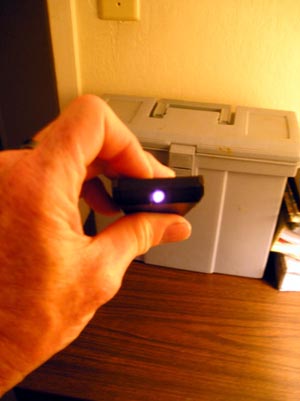Infrared Remote Control

Invisible Beams
Infrared Remote Control

Invisible Beams
Introduction
Investigate the infrared beam that comes from your television remote control.
Material
A television with a remote control.
A ziploc bag full of water.
A black plastic trashbag.
A piece of plastic.
A metal frypan, or pot, not Teflon coated. A copper bottom pan works best, but any shiny metal will work.
A clean piece of white paper
Optional, a digital camera.
To Do and Notice
Press a button on the remote control while looking at the end that you normally point at the television. Notice that you don't see anything, even in a dark room.
Optional, point the remote control at a digital camera while watching the monitor screen on the camera. Press a button on the remote control and notice that you can see a flashing light. The digital camera is sensitive to infrared light while your eyes are not.
Use the remote control to change channels on a television.
Now try to change channels while pointing the remote control through a ziploc bag of water. Try several bags.
Try to change channels while pointing the remote control through a single layer of black plastic trash bag material. Then shine it through two layers.
Try reflecting the beam off a piece of plastic, off the outside bottom of a metal frypan, off a plastic mirror. (With the mirror point the remote at the image of the TV in the mirror.)
Try shooting it through a piece of white paper. What is the operating range of the controller?
Come up with your own experiments.
What's Going On?
Infrared light interacts with materials in different ways than visible light. In the electromagnetic spectrum infrared light is below the red end of the spectrum of visible light. It has lower frequency, longer wavelengths and less energy per photon than red light. Human eyes cannot see infrared light.
Water absorbs infrared light so a ziploc bag full of water will decrease the brightness of the infrared signal.
Thin black plastic trashbag material blocks visible light but allows infrared light to pass through. So the control signal may pass through the plastic bag material.
Plastic does not reflect infrared light as well as it does visible light.
Infrared light does reflect off of metal surfaces, even ones that don't look like a mirror to our eyes such as the copper bottom of a fry pan or pot.
The plastic on a plastic mirror will absorb some the infrared beam as it passes through on its way to and from the metal coating on the back of the mirror. So the infrared beam won't reflect as well as visible light from the plastic mirror.
The paper will scatter the infrared, but the IR will still pass through the paper so the range over which the remote control works might decrease.
Etc.
Infrared light spans a large range of frequencies and wavelengths. It is commonly divided into near infrared and far infrared. The near infrared is close to red light. The TV remote control works in the near infrared. Thermal cameras like those that you see in science museums work in the far infrared. They show the infrared light emitted by warm objects.
|
Scientific Explorations with Paul Doherty |
|
7 May 2004 |